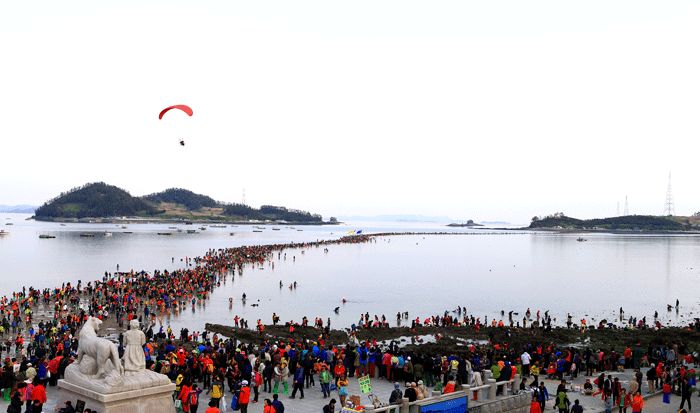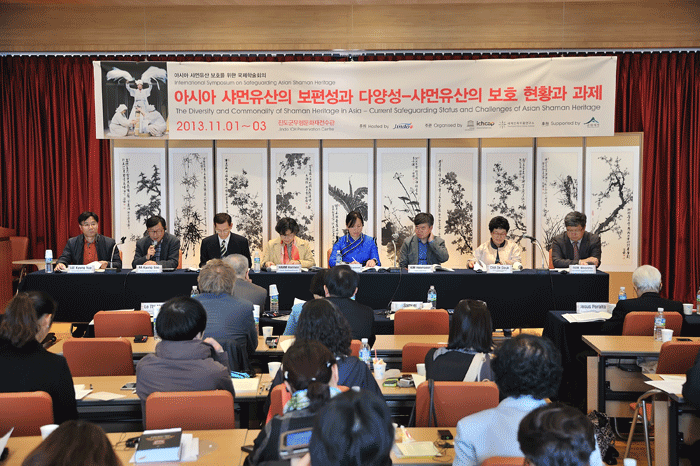1,000 foreigners to carry torches in a pre-festival event
Once a year in Jindo Island in South Jeolla Province, the sea is split mysteriously and the visitors can walk on the way made so made as if by Moses in Egypt.

This phenomenon is caused due to the difference between high and low tides, which creates a 2.8-kilometer-long way measuring 40 to 60 meters in width. This is celebrate every year by the government and people of the Jindo County, which is named "Jindo Miracle Sea Festival."
Visitors can enjoy walking along the sea road, collecting clams, abalone and various other marine products. The sea-splitting lasts for over an hour, allowing people to walk through the sea and meet halfway from both sides. Some people go to Modo Island before the sea road opens by boat so that they can cross the sea with ease. Walking through the water requires a pair of long lubber boots, a plastic rain coat in case of rain, and a small container to put their clams, small fish, or sea tangle on the way round.

The Jindo Miracle Sea Festival is set to take place between March 30 and April 2 this year. It attracts more than half a million visitors every year. It was designed as one of Korea's best festivals by the central government in 2013 as it was inundated with 510,000 visitors including 75,000 foreigners in the year.
Of particular note, a pre-festival event in which a throng of about 1,000 foreigners will walk the sea road carrying torches at dawn is set to take place for two days between March 1 and March 2. During the festival, traditional Korean songs and dances including "Ganggang sulle" (Circle Dance), which was designated as a UNESCO World Heritage, and "Jindo Arirang,” will be performed, along with "Jindo Buknori." There will also be performances of Jindo Dogs, which are famous for their intelligence and loyalty.

While the waters usually part 2-3 times each spring between the months of March and June, the celebration itself takes place just once per year. The four festival days reach their apex in the late afternoon, when the tides get so low that a land bridge between the islands emerges for approximately 60-90 minutes.
Today’s festival is more about food, fun and foraging than escaping ferocious beasts. The 2.9 kilometer, 40-meter wide sea path is of course the biggest draw, but visitors often spend more time enjoying local delicacies. Travelers can also bring a bucket and race to gather up the thoroughly confused abalone, clams, crabs and octopi stranded on the path, and even have them cooked to order in one of the many tent restaurants.

The phenomenon of sea parting came to international prominence in 1975 when then French Ambassador to Korea Pierre Randi visited Jindo, witnessed the miracle first-hand and introduce it as the Korean version of the “Moses Miracle" in a French newspaper. Since then, the phenomenon has attracted a growing number of people from many parts of the world, and the locals organized a festival to celebrate the miraculous event in 1978.
In the approach of the sea road, a giant statue of an old lady named Grandma Bbong with a tiger tells a story about the origin of the sea road. Legend says the village of Jindo was threatened by a frequent attack of bloodthirsty tigers. Everyone managed to escape to the neighboring Modo village, but an old woman was left behind. Missing her family so much, she prayed with all her heart to the sea god to grant her passage to meet her loved ones. The deity took pity on her and split the water allowing her to escape the fierce beasts and to rejoin her family. At last, she reunited with her family and other villagers who came to rescue her with the sea road open. She was so pleased to see them and died happily. From then, the villagers have held memorial service for the Grandma Bbong twice a year so that they could live in well-being with a big catch of fish and a good harvest for products all year round.

Meanwhile, Jindo County, which was designated as a special traditional culture and art development entity by the Small and Medium Business Administration in 2013, will accelerate its efforts to build up the platform for a distinctive cultural and artistic city and promote its brand value. By 2017, the county plans to build a “cluster of folk culture” with a budget of 37 billion won, while pushing for the project to globalize "Jindo Arirang."
Furthermore, Jindo is seeking to place its distinctive commemorative rites for ancestors on the list of UNESCO World Heritage. Toward this end, in late 2013, the county hosted an international shaman heritage forum which attracted a number of Korean and foreign shamans, including those from Mongolia, Japan, Vietnam, Myanmar and India.

In the field of international fisheries cooperation, Dalian Zhangzido Fishery Group (Zhangzido Group) has decided to invest US$100 million in breeding and processing facilities in sea cucumber and abalone in Jindo. When completed in 2016, the facilities will contribute to facilitating Jindo's exports of marine products to China.

